
The Curfew Tower
Pictures
from 1770 and later

The famous 'pepper
pot' shape of the Curfew Tower, at the far left of the castle
from a panorama taken in the 1990s To see a larger version of
this panorama, click here
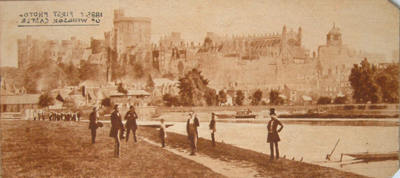
A view of the castle
from the 1850s showing the earlier square Curfew Tower belfry
This image, which claims to be 'the earliest photograph of Windsor',
features in its own story here

Pictures from 1770 and later |
One of the delights of looking
after the Royal Windsor Website is that every so often some really
early pictures come along that illustrate how the town and the
castle have developed over the years. Four such images surfaced
in July 2003 and one more in February 2007, from a variety of
separate sources, illustrating, sometimes by accident, the Curfew
Tower and nearby buildings.
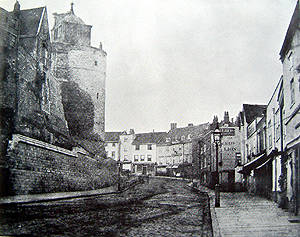
Thames Street and the earlier
square belfry at the top of the Curfew Tower, often known as
the Clewer Tower in earlier times, photographed by Arthur J Melhuish
in 1856, seven years before work began on the Tower.
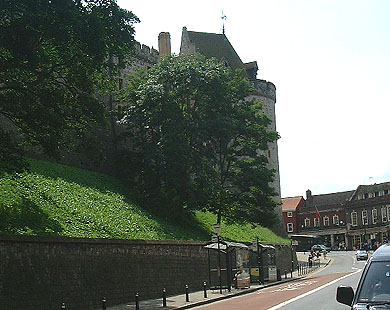
A similar view 144 years
later in 2000
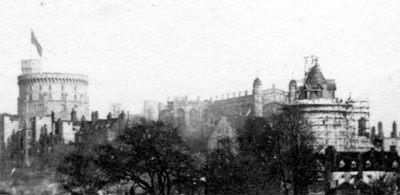
Curfew Tower surrounded
by scaffolding
The picture
above was found in an album containing pictures dated 1856 though
this image is certainly later. Two dates are possible. The earlier
is during the original construction of the new roof of the Curfew
Tower in 1863, or later, from 1885, when further attention was
required to the stone work of the west front, including the Curfew
Tower. This additional attention was necessary because the stone
facing work of 1860 was rapidly deteriorating. In 1859 the west
front of the castle had been in a sorry state, the Garter Tower
being in a very poor condition indeed. In 1860 therefore Anthony
Salvin, was charged with restoring the west front as part of
a general restoration of the Lower Ward. Unfortunately, the stone
he chose for the job was just too soft and so in 1885 the Curfew,
Garter and Salisbury Towers were refaced once again, this time
with heath stone from High Wycombe. [Source Windsor Castle:
Olwen Hedley, p. 201]
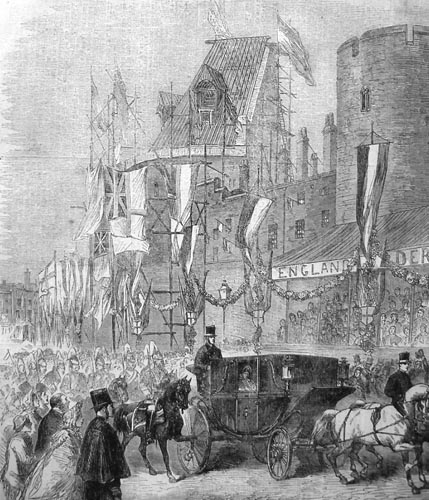
10 March 1863 and Princess
Alexandra is riding in her carriage to St George's Chapel for
her wedding to Prince Albert (to become Edward VII in 1901) and
in the background is the Curfew Tower surrounded by scaffolding.
We believe that the following
two images, taken from extremely rare stereoviews, show the stonemason's
yard in the Lower Ward of the castle, and the carts used to take
dressed stone through the Horseshoe Cloisters, to the top of
the Curfew Tower.
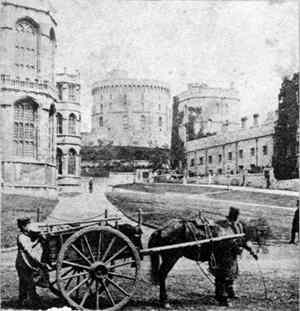
The picture
above, taken from a stereoview, is also believed to date from
1863. A cart has just come out of the archway leading to
the Horseshoe Cloisters. It was probably loaded with stone associated
with the work on the Curfew Tower and west front. Note the figure
sitting on the fence, extreme right, and the ghostly image of
the horses head! It must have nodded as the photo was taken for
photographic exposure times in those days were quite slow, often
several seconds. Towards the middle left of the picture there
is another figure who also appears in the picture below.
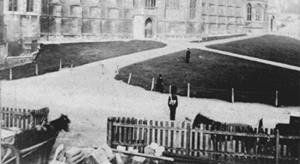
In this view,
an extract from a second stereoview of the Lower Ward, the stones
are clearly visible, fenced off from the public area. Also, note
the soldier on guard, centre, and above him to the left, a figure
seated by the fence. This same figure appears in the first picture
above at the far right. We are satisfied that these two views
were photographed on the same day, probably during the west front's
restoration.
A Note about Stereoviews
Stereoviews provide a stereoscopic,
3D, effect when looked at through a viewer. Two images are required,
one just to one side of the other, exactly as the human eye sees
the view. The brain then combines the images and the 3D effect
is created for the individual looking at the images. Some of
the earliest stereoviews were created for the Great Exhibition
of 1851 in London at the Crystal Palace. In the mid 20th century
Viewmaster used the same principle with pairs of images incorporated
into a disk which slotted into the viewer.
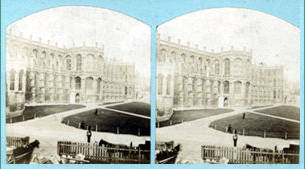
The original stereoview above came from a bundle of stereo cards. Those
that were dated were all either 1858 or 1859. Early stereoviews
were made flat, with square corners on the card mounts, until
1865. From 1865 to 1890 the cards were still flat but with rounded
corners as the manufacturers learned that the corners would otherwise
become 'bumped' and damaged. After 1890 the cards were made with
curved mounts ('warped' stereoviews) as they felt they got better
stereo and more strength.
Colour was very rare in Victorian times
and could only be created by hand-tinting both images. The coloured
stereo below is therefore very sought after.
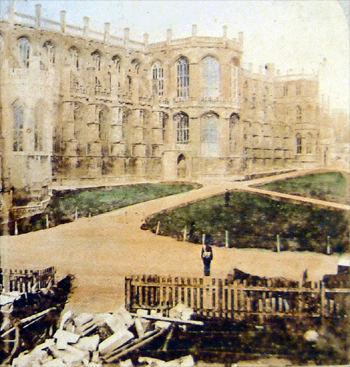
One of the delights of looking after the Royal Windsor Website is that every so often some really early pictures come along that illustrate how the town and the castle have developed over the years. Four such images surfaced in July 2003 and one more in February 2007, from a variety of separate sources, illustrating, sometimes by accident, the Curfew Tower and nearby buildings.
A similar view 144 years later in 2000
Curfew Tower surrounded by scaffolding The picture above was found in an album containing pictures dated 1856 though this image is certainly later. Two dates are possible. The earlier is during the original construction of the new roof of the Curfew Tower in 1863, or later, from 1885, when further attention was required to the stone work of the west front, including the Curfew Tower. This additional attention was necessary because the stone facing work of 1860 was rapidly deteriorating. In 1859 the west front of the castle had been in a sorry state, the Garter Tower being in a very poor condition indeed. In 1860 therefore Anthony Salvin, was charged with restoring the west front as part of a general restoration of the Lower Ward. Unfortunately, the stone he chose for the job was just too soft and so in 1885 the Curfew, Garter and Salisbury Towers were refaced once again, this time with heath stone from High Wycombe. [Source Windsor Castle: Olwen Hedley, p. 201]
We believe that the following two images, taken from extremely rare stereoviews, show the stonemason's yard in the Lower Ward of the castle, and the carts used to take dressed stone through the Horseshoe Cloisters, to the top of the Curfew Tower. 
The picture above, taken from a stereoview, is also believed to date from 1863. A cart has just come out of the archway leading to the Horseshoe Cloisters. It was probably loaded with stone associated with the work on the Curfew Tower and west front. Note the figure sitting on the fence, extreme right, and the ghostly image of the horses head! It must have nodded as the photo was taken for photographic exposure times in those days were quite slow, often several seconds. Towards the middle left of the picture there is another figure who also appears in the picture below.
In this view, an extract from a second stereoview of the Lower Ward, the stones are clearly visible, fenced off from the public area. Also, note the soldier on guard, centre, and above him to the left, a figure seated by the fence. This same figure appears in the first picture above at the far right. We are satisfied that these two views were photographed on the same day, probably during the west front's restoration.
|
The Curfew Tower before
1863
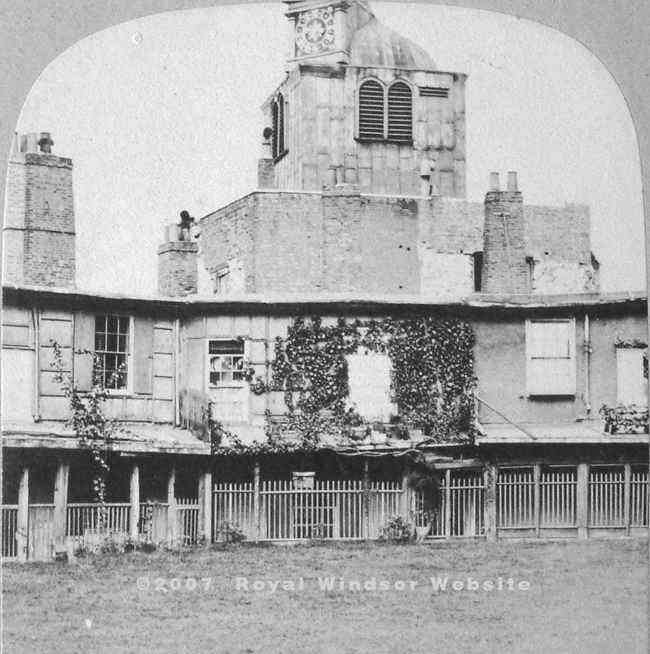
The Curfew Tower
and Horseshoe Cloisters in the 1850s
from an exceptionally rare, early stereoview in the Royal Windsor
Website Collection
In the stereoview above, which was purchased
by the Royal Windsor Website in February 2007, the earlier roofline
of the Curfew Tower is clearly visible, with its single clockface
still facing approximately east. Beneath the clocktower is what
is now known as the Horseshoe Cloister. Paul Sandby had painted
a very similar scene almost 100 years earlier, shown below. The
cloister will be the subject of another RWWS article in the future,
but for now suffice it to say that in the mid-Victorian times
they were in need of considerable restoration and refurbishment.
This was to take place in 1870 when the Tudor style we know today
was restored to the entire cloister and the central wall was
removed.
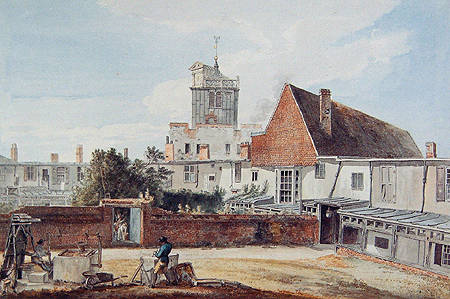
We are indebted to W H St John Hope and
his major publication Windsor Castle (1913) for these
references. St John Hope was not impressed with the new Victorian
roofline and refacing of the Curfew Tower writing in 1913 of
the 'disfigurement' of the original structure.
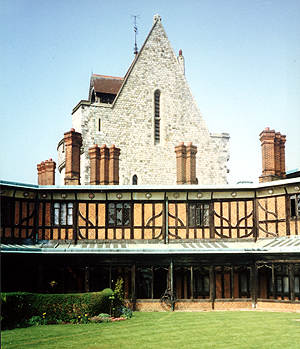
A view of the Curfew
Tower from within the Horseshoe Cloister in 2000
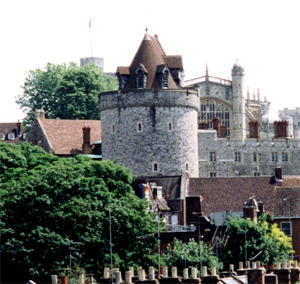
The Curfew Tower
from the Central Railway Station
The Curfew Tower was originally built between
1227 and 1230 and was for several centuries known as the Clewer
Tower. Later it was also known as the Bell Tower as it was the
belfry for St George's Chapel during its construction in the
reign of Edward IV in about 1474.
The present roof was copied from La Tour du Trésau,
Carcassonne, France at the suggestion of Albert, The Prince Consort.
It is likely that he was given the idea by Emperor Napoleon III
who had made a State Visit to Windsor in 1855 while the Carcassonne
tower was being repaired.
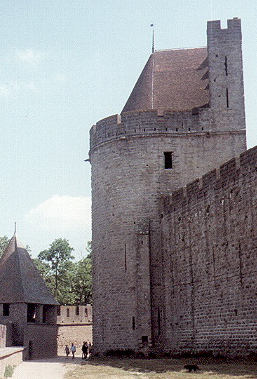
La Tour du Trésau
(The Treasury Tower)
This tower is one of the most beautiful and imposing towers in
the city of Carcassonne. It gave Prince Albert the idea for the
roof line for the restored Curfew Tower at Windsor in 1863.
[Carcassonne Web Site]

A remarkably similar
view of the Curfew Tower taken in around 1900.
A modern taxi rank remains to this day as do the iron bars set
in the curb to stop the horse-drawn cabs from running back down
the hill. [2003]
The History
Zone Index
Royal
Windsor Home Page

To contact us,
email Thamesweb.
|
In the stereoview above, which was purchased by the Royal Windsor Website in February 2007, the earlier roofline of the Curfew Tower is clearly visible, with its single clockface still facing approximately east. Beneath the clocktower is what is now known as the Horseshoe Cloister. Paul Sandby had painted a very similar scene almost 100 years earlier, shown below. The cloister will be the subject of another RWWS article in the future, but for now suffice it to say that in the mid-Victorian times they were in need of considerable restoration and refurbishment. This was to take place in 1870 when the Tudor style we know today was restored to the entire cloister and the central wall was removed.
We are indebted to W H St John Hope and his major publication Windsor Castle (1913) for these references. St John Hope was not impressed with the new Victorian roofline and refacing of the Curfew Tower writing in 1913 of the 'disfigurement' of the original structure.   The Curfew Tower was originally built between
1227 and 1230 and was for several centuries known as the Clewer
Tower. Later it was also known as the Bell Tower as it was the
belfry for St George's Chapel during its construction in the
reign of Edward IV in about 1474. 
To contact us, email Thamesweb.
|